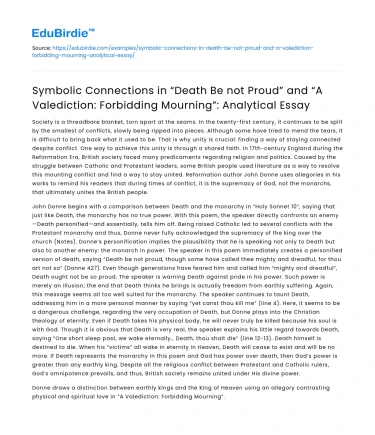Society is a threadbare blanket, torn apart at the seams. In the twenty-first century, it continues to be split by the smallest of conflicts, slowly being ripped into pieces. Although some have tried to mend the tears, it is difficult to bring back what it used to be. That is why unity is crucial: finding a way of staying connected despite conflict. One way to achieve this unity is through a shared faith. In 17th-century England during the Reformation Era, British society faced many predicaments regarding religion and politics. Caused by the struggle between Catholic and Protestant leaders, some British people used literature as a way to resolve this mounting conflict and find a way to stay united. Reformation author John Donne uses allegories in his works to remind his readers that during times of conflict, it is the supremacy of God, not the monarchs, that ultimately unites the British people.
John Donne begins with a comparison between Death and the monarchy in “Holy Sonnet 10”, saying that just like Death, the monarchy has no true power. With this poem, the speaker directly confronts an enemy—Death personified—and essentially, tells him off. Being raised Catholic led to several conflicts with the Protestant monarchy and thus, Donne never fully acknowledged the supremacy of the king over the church (Notes). Donne’s personification implies the plausibility that he is speaking not only to Death but also to another enemy: the monarch in power. The speaker in this poem immediately creates a personified version of death, saying “Death be not proud, though some have called thee mighty and dreadful, for thou art not so” (Donne 427). Even though generations have feared him and called him “mighty and dreadful”, Death ought not be so proud. The speaker is warning Death against pride in his power. Such power is merely an illusion; the end that Death thinks he brings is actually freedom from earthly suffering. Again, this message seems all too well suited for the monarchy. The speaker continues to taunt Death, addressing him in a more personal manner by saying “yet canst thou kill me” (line 4). Here, it seems to be a dangerous challenge, regarding the very occupation of Death, but Donne plays into the Christian theology of eternity. Even if Death takes his physical body, he will never truly be killed because his soul is with God. Though it is obvious that Death is very real, the speaker explains his little regard towards Death, saying “One short sleep past, we wake eternally… Death, thou shalt die” (line 12-13). Death himself is destined to die. When his “victims” all wake in eternity in Heaven, Death will cease to exist and will be no more. If Death represents the monarchy in this poem and God has power over death, then God’s power is greater than any earthly king. Despite all the religious conflict between Protestant and Catholic rulers, God’s omnipotence prevails, and thus, British society remains united under His divine power.
Save your time!
We can take care of your essay
- Proper editing and formatting
- Free revision, title page, and bibliography
- Flexible prices and money-back guarantee
Donne draws a distinction between earthly kings and the King of Heaven using an allegory contrasting physical and spiritual love in “A Valediction: Forbidding Mourning”. Donne writes this poem on the occasion of separation from his wife, forbidding her from mourning. He declares that his love is spiritual in nature, transcending all mundane obstacles and they need not the exaggerated emotions of a shallower, physical love. These “dull sublunary lovers’ love…cannot admit absence” and are unable to experience separation without losing the sensation of love (Donne 424). The word “sublunary” means to belong to this world, as contrasted with a better or more spiritual one. “Sublunary” connotes a feeling of the temporary, easily corruptible. Those relationships exist under the moon, rather than in the sky. This type of love cannot endure the forces of separation because the “heart” of the relationship is defined by physicality, with touch and sight held with utmost importance. But Donne’s spiritual, “refined” love, on the other hand, will hold strong; the pair will be bound together regardless of any earthly distance between them. Donne’s comparison of the two types of love implies another connection to the monarchy: the superficial, sublunary love represents earthly kings, while his transcendent love represents God, the King of the Heavens. Earthly relationships do not last and break easily under pressure, indicative of the weakness of earthly kings. On the contrary, spiritual relationships prevail through hardships, proving that once again, the abiding power of God is durable even during the conflict faced by British society during the Reformation era.
In both of his poems, John Donne relies on symbolic connections to bring his audience to the conclusion that, ultimately, it is the supremacy of God and not of the monarchs that promotes unity in the conflict caused by a theological schism. Although death and love are on two ends of the spectrum, Donne successfully portrays them in a way that guides the reader back to the same subject: the monarchy. Donne uses Death to represent a monarch and strips him of any power by tapping into the Christian doctrine of eternal life after death. Donne compares two types of love—physical and spiritual—to differentiate between earthly kings and the King of Heaven. Although the conflicts between Protestant and Catholic are no longer so serious urgent in the twenty-first century, new conflicts have arisen since, and it is up to society to decide on how to stay united and keep the blanket from ripping into two.






 Stuck on your essay?
Stuck on your essay?

